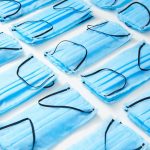You’ll find nonwoven polypropylene fabric is lightweight, durable, and breathable, making it perfect for medical gowns, masks, and hygiene products like diapers. It’s tear-resistant, moisture-repellent, and cost-effective, plus recyclable and eco-friendly options are emerging. You’ll also see it used in agriculture, packaging, and industrial filters due to its strong, quick-drying nature. If you want to understand its manufacturing process and exciting innovations, there’s plenty more to discover about this versatile material.
Table of Contents
Key Takeaways
- Nonwoven polypropylene fabric is made by bonding fibers without weaving, resulting in a lightweight, strong, and moisture-resistant material.
- It is breathable, chemically inert, and widely used in medical and hygiene products like surgical gowns and disposable masks.
- The fabric’s durability, tensile strength, and abrasion resistance make it suitable for various industrial and consumer applications.
- Manufacturing involves fiber spinning, web formation, and bonding using heat or chemicals to create versatile, cost-effective fabric.
- Innovations focus on eco-friendly materials, enhanced strength, antimicrobial properties, and smart textile integration for health monitoring.
What Is Nonwoven Polypropylene Fabric?
Nonwoven polypropylene fabric is a versatile material made by bonding polypropylene fibers together without weaving or knitting.
When you use this fabric, you benefit from its lightweight yet strong structure, which resists tearing and moisture. You’ll find it’s breathable, allowing air to pass through while keeping liquids out, making it ideal for various protective applications.
Because it’s chemically inert, you won’t have to worry about it reacting with most substances, which is why it’s popular in medical and hygiene products.
Its chemical inertness makes it ideal for safe use in medical and hygiene products.
Plus, it’s cost-effective and recyclable, so you’re making an environmentally conscious choice.
Whether you’re looking for something durable, water-resistant, or disposable, nonwoven polypropylene fabric offers a practical solution that fits many needs without sacrificing performance.
How Is Nonwoven Polypropylene Fabric Manufactured?
You might wonder how a fabric that’s both lightweight and strong comes to life. Nonwoven polypropylene fabric is made through a straightforward but efficient process. First, polypropylene granules melt and transform into fine fibers. Then, these fibers are laid randomly on a conveyor belt, creating a web. Finally, the web is bonded together using heat, pressure, or chemicals to form a durable fabric.
Here’s a quick look at the main manufacturing steps:
| Step | Process Description | Result |
|---|---|---|
| Fiber Spinning | Melting polypropylene | Fine fibers formed |
| Web Formation | Laying fibers randomly | Loose fiber web |
| Bonding | Heat, pressure, or chemicals | Strong fabric formed |
This method guarantees you get a versatile, cost-effective fabric ready for many uses.
Key Properties of Nonwoven Polypropylene Fabric
You’ll notice nonwoven polypropylene fabric stands out because of its durability and strength, making it ideal for heavy-duty uses.
It also resists moisture effectively, which helps keep things dry and clean.
Let’s explore these key properties to understand why this fabric is so versatile.
Durability and Strength
Although it might seem lightweight, polypropylene fabric holds up remarkably well under stress, making it a reliable choice for various applications.
When you handle this fabric, you’ll notice its impressive tensile strength, which allows it to resist tearing and stretching even during heavy use. Its durability means it stands up to repeated wear and mechanical stresses without losing integrity.
You’ll also find that polypropylene’s resistance to abrasion helps maintain its structure and appearance over time. This strength makes it ideal for items that require toughness without added bulk, such as reusable shopping bags, geotextiles, and medical masks.
Moisture Resistance Features
Moisture resistance stands as one of the standout features of nonwoven polypropylene fabric, making it a go-to material in many wet or humid conditions.
You’ll find that it doesn’t absorb water, which helps prevent mold, mildew, and bacterial growth. This property keeps the fabric lightweight and maintains its strength even when exposed to moisture.
Because it repels water, you can rely on it for applications like medical gowns, filters, and packaging where dryness is essential. Additionally, its quick-drying nature means it won’t stay damp long, reducing discomfort or damage during use.
When you need a fabric that performs well in damp environments, nonwoven polypropylene’s moisture resistance guarantees durability and hygiene without sacrificing comfort or functionality.
Benefits of Using Nonwoven Polypropylene Fabric
When you choose nonwoven polypropylene fabric, you benefit from its durability, lightweight nature, and cost-effectiveness. This fabric stands up well to wear and tear, so it lasts longer in various uses.
You’ll appreciate how light it feels, making it easy to handle and transport without adding bulk. Plus, it’s one of the more affordable materials, helping you save money without sacrificing quality.
Its resistance to moisture and chemicals means it stays reliable in different environments. Since it’s easy to produce and customize, you can find options suited to your specific needs.
Applications in Medical and Hygiene Products
Beyond its durability and affordability, nonwoven polypropylene fabric plays an essential role in medical and hygiene products. When you use disposable surgical gowns, face masks, or caps, you’re relying on this fabric’s excellent barrier properties that help prevent contamination.
It’s lightweight, breathable, and resistant to fluids, so it keeps both patients and medical staff safe. In hygiene products like diapers, sanitary pads, and wipes, it offers softness and absorbency while maintaining strength.
You’ll also find it in protective covers and sterilization wraps, ensuring a sterile environment. Because it’s cost-effective and disposable, nonwoven polypropylene fabric helps you maintain hygiene standards without sacrificing comfort or protection, making it indispensable in healthcare settings.
Use in Environmental and Agricultural Sectors
Although nonwoven polypropylene fabric is best known for medical uses, it’s also crucial in environmental and agricultural sectors.
You’ll find it playing a significant role in protecting crops, controlling erosion, and supporting sustainable farming practices. Here’s how you can see it in action:
- Crop Covers: Shields plants from pests and harsh weather without blocking sunlight or air.
- Weed Barriers: Prevents weed growth while allowing water and nutrients to reach the soil.
- Soil Stabilization: Helps stop erosion on slopes and construction sites by holding soil in place.
- Seed Germination: Creates ideal moisture and temperature conditions to boost seed sprouting.
Using this fabric, you can enhance productivity and environmental protection simultaneously, making it a smart choice for your agricultural needs.
Role in Packaging and Industrial Uses
Nonwoven polypropylene fabric offers versatile solutions in packaging and industrial settings. When you use this fabric, you benefit from its durability, lightweight nature, and resistance to moisture and chemicals.
It’s perfect for making reusable bags, protective covers, and liners that keep products safe during shipping and storage. In industrial environments, you’ll find it valuable for filtration systems, insulation, and protective clothing, helping to improve safety and efficiency.
Its ability to withstand stress and tear guarantees your packaging stays intact and your industrial processes run smoothly. By choosing nonwoven polypropylene, you’re opting for a cost-effective, reliable material that meets diverse needs without compromising on performance or sustainability.
This fabric truly enhances how you manage packaging and industrial tasks.
Innovations and Future Trends in Nonwoven Polypropylene Fabric
As technology advances, you’ll see nonwoven polypropylene fabric evolving with new innovations that boost its performance and sustainability.
Manufacturers are developing eco-friendly variants by incorporating recycled materials and enhancing biodegradability. You can expect improvements in fabric strength and softness, making it more versatile across industries.
Eco-friendly fabrics with recycled content and improved softness are expanding versatility across industries.
Smart fabrics embedded with sensors for health monitoring or environmental detection are emerging as well.
Here are key trends shaping its future:
- Increased use of recycled and bio-based polypropylene to reduce environmental impact.
- Enhanced filtration capabilities for medical and industrial applications.
- Integration of nanotechnology for added functionality like antimicrobial properties.
- Development of smart, responsive fabrics that interact with users or surroundings.
Frequently Asked Questions
How Should Nonwoven Polypropylene Fabric Be Disposed of Safely?
You should dispose of nonwoven polypropylene fabric by checking local recycling guidelines, as some facilities accept it. If recycling isn’t available, place it in the trash to prevent environmental contamination and avoid burning it.
Can Nonwoven Polypropylene Fabric Be Recycled?
Yes, you can recycle nonwoven polypropylene fabric, but it depends on local facilities. Check if your recycling center accepts it to guarantee proper processing, since not all centers handle this material routinely.
Is Nonwoven Polypropylene Fabric Hypoallergenic?
Yes, nonwoven polypropylene fabric is hypoallergenic, so you won’t usually experience allergic reactions when using it. Its synthetic nature makes it resistant to common allergens, making it a safe choice for sensitive skin or medical applications.
How Does Nonwoven Polypropylene Compare to Woven Polypropylene?
You’ll find nonwoven polypropylene lighter, more breathable, and cheaper than woven polypropylene. It’s less durable but offers better filtration, while woven is stronger, reusable, and ideal for heavy-duty uses or long-term applications.
What Are the Environmental Impacts of Producing Nonwoven Polypropylene?
You’ll find producing nonwoven polypropylene consumes less energy than woven types but still relies on fossil fuels. It generates plastic waste and emissions, so recycling and proper disposal are key to reducing its environmental footprint.
- The Use of Nonwovens in Construction and Civil Engineering - July 11, 2025
- The Use of Nonwovens in Construction and Civil Engineering - July 11, 2025
- The Use of Nonwovens in Construction and Civil Engineering - July 11, 2025






